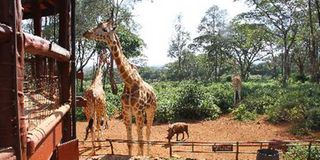Fun in the suburbs of Langata

Giraffes and a warthog at the Giraffe Centre in the Langata suburb of Nairobi. PHOTO | MARTIN MUKANGU
What you need to know:
- Langata is one-of-kind suburb, where lions roam free and Black rhino browse in the sanctuary within Nairobi National Park. It also boasts the first place where the endangered Rothschild giraffe, the rarest of the nine sub-species of the African giraffes, were translocated from Soy in western Kenya to Nairobi.
- With the Galleria, Nairobi’s upmarket shopping complex, only a few minutes down the road, we have a choice to go out for dinner or stay in camp.
In the depths of the night, we hear a sound from afar.
It’s the deep-throated growl of a lion – the only sound that breaks the darkness. It’s unbelievable that we hear this in a Nairobi suburb.
Langata is one-of-kind suburb, where lions roam free and Black rhino browse in the sanctuary within Nairobi National Park.
It also boasts the first place where the endangered Rothschild giraffe, the rarest of the nine sub-species of the African giraffes, were translocated from Soy in western Kenya to Nairobi.
It’s here where you can stretch your imagination to a little more than a 100 years when there were no fences and roads and wildebeest migrated across the grasslands and swamps of Langata following the rains and the grass to lands beyond.
LIONS ROAR
It’s this imagination that has the life-size scrap metal wildebeest running on the grassland at the aptly named Wildebeest Eco-Camp in Langata.
Robert Bogonko takes me for a stroll around the garden of the eco-camp that is bursting with colours of every flower in season. I’m amazed that a tented camp exists here in the heart of a city suburb.
Beautiful acacias attract the big birds like the African harrier hawk and the owls, which perch on them.
When Lynita Harris, the business director at the camp, and her partner Allan Wickham started a business where essentially people like them who enjoy travel, can stay at places that have an atmosphere and don’t cost the earth.
With the Galleria, Nairobi’s upmarket shopping complex, only a few minutes down the road, we have a choice to go out for dinner or stay in camp.
The full moon is over the pond and the sounds of the frogs and crickets as a natural backstage orchestra makes us choose to dine in. It is a beautiful night with a dazzling full moon and a garden lit with lanterns – all solar-powered. But then the clouds rush in to hide the silver orb and suddenly there’s a shower.
It is when I hear the lion’s roar the first time that Lynita asks, “Can you hear the lions?”
The night passes and the morning brings with it the sun, filling the garden with all the smaller birds fluttering around – the sunbirds, the weavers and the wagtail.
ZIP LINING
With the space around, there’s another surprise – and a new activity in the city – zip-lining. Used first by forest researchers to explore forest canopies, zip-lining has become popular with people wanting to experience the thrill of ‘zipping’ through the air or looking at life that’s in the tree canopies.
With the mention of forests, I’m all set to visit the Ngong Road Forest Sanctuary – just a few minutes’ drive from Wildebeest Eco-Camp.
It’s a remaining tract of Nairobi’s indigenous forest set on 538 hectares, providing a green lung in the city. It’s a fantastic walk through this pristine forest with the iconic Ngong Hills in the skyline.
I still have to see the elusive leopard and the aardvark, or one of the 20 species of snakes listed. Some, like the Jackson’s wolf snake, are so rare that this is their only refuge.
It’s intriguing that we don’t have wolves in Africa but instead we have a wolf snake that looks like anything but a wolf. Wolf snakes are constrictors like pythons and boas and also resemble the python in head shape and defensive posture.
None have venom fangs which is good because this means they are not venomous and so are totally harmless to humans. So we need to be kinder to them because they eat pests like rats.
Just walking in this city forest makes me happy. It has trees that I have seen in distant forests of northern Kenya like the towering Juniperus procera, the tallest of all juniper species in the world.
It is nicknamed the African pencil cedar because it used to be used extensively in the manufacture of pencils. It’s a prized timber tree and may in the foreseeable future be threatened by ‘tree poachers’.
My trip in Langata reminds me that Nairobi is an amazing city where the wild is juxtaposed with the contemporary.
_________
EXPLORING LANGATA
If you’re from out of Nairobi you’ll have lots of fun in Langata, be it game drives in the national park, or feeding giraffes at Giraffe Centre, or even a stroll at the mall. For more things to do around Langata log on to www.ngongforest.org, www.giraffecenter.org and www.kws.org.




